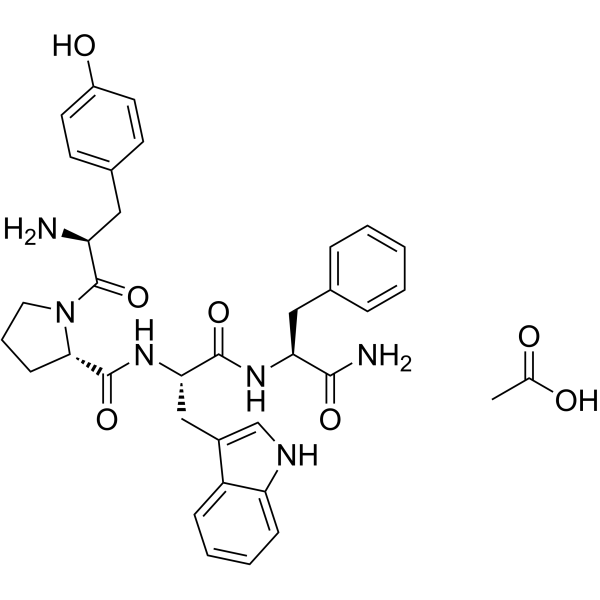1276123-71-7
| Name | Endomorphin 1 acetate |
|---|
| Description | Endomorphin 1 acetate, a high affinity, highly selective agonist of the μ-opioid receptor (Ki: 1.11 nM), displays reasonable affinities for kappa3 binding sites, with Ki value between 20 and 30 nM. Endomorphin 1 acetate has antinociceptive properties[1][2][4]. |
|---|---|
| Related Catalog | |
| Target |
μ Opioid Receptor/MOR:1.11 nM (Ki) |
| In Vitro | Endomorphin 1 acetate inhibits Forskolin (HY-15371) (1 μM) stimulated cyclic AMP formation with a pIC50 value of 8.03 in In CHOμ cells[5]. Endomorphin 1 (1-10 μM) acetate increases interleukin-8 secretion in Caco-2 cells[6]. Endomorphin 1 (1 μM) acetate inhibits excitatory transmission in adult rat substantia gelatinosa neurons[7]. |
| In Vivo | Endomorphin 1 (i.c.v.) acetate shows antinociceptive properties in mice, with an ED50 value of 6.16 nM[2]. Endomorphin 1 (50 μg/kg, i.v., rats) acetate alleviates myocardial ischemia/reperfusion injury (MIRI) by inhibiting the inflammatory response[3]. Animal Model: ICR mice[2]. Dosage: 6.16 nM (ED50) Administration: Intracerebroventricularly (i.c.v.) injection Result: Inhibited dose-dependently the tail-flick response. Animal Model: Rats[3]. Dosage: 50 μg/kg Administration: Intravenously following LAD ligation for 25 min, subsequently the LAD was reperfused for 120 min. Result: Alleviated MIRI by reducing the production of free radicals. Dncreased LDH and CK-MB activities. Increased SOD activity and decreased MDA content. Decreased IL-6 and TNF-α plasma content. |
| Molecular Formula | C36H42N6O7 |
|---|---|
| Molecular Weight | 670.75 |
